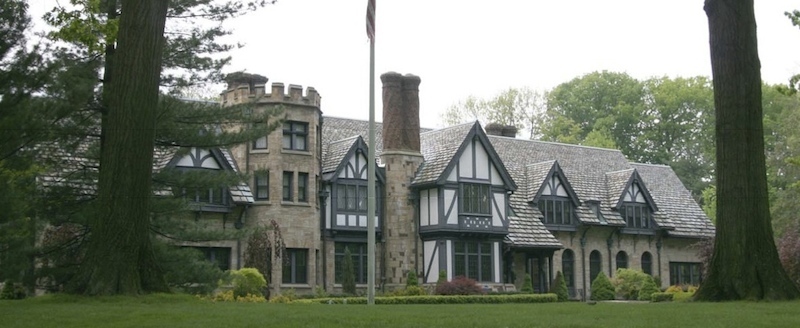Van Sweringen Residence

Accompanied by a photograph of the recently constructed home at what is now 17400 South Park Boulevard, a 1910 Cleveland Plain Dealer article muses: "Shakers Would Be Surprised Were They To Return and See The Van Sweringen Home". The image centers on a stone pathway leading through a beautifully maintained and vast lot. A mansion can be seen in the distance, hidden away behind a grouping of well-placed trees. The brief article continues to ooze over the country home, exclaiming it to be "as large...as the royal stable of the czar, and as elegant as a genii palace in the Arabian nights, yet as homelike and refined as...a Maxfield Parrish drawing." Moving beyond the author's assertion that the residence was sufficient bait for the bachelor Van Sweringen boys to enter into a married state when they became ready, the massive home was a reflection of the elite suburban community envisioned and sold by the brothers.
Ten years prior to the publication of the Plain Dealer article, Oris Paxton and Mantis James Van Sweringen, 21 and 19 respectively, were just entering the business of real estate. Having worked a series of odd jobs since their early teens, neither had much experience in land speculation. This quickly culminated in a failed first effort to develop land in Lakewood, where a foreclosure judgment was entered against them after they overextended their debt. Soon after, however, they would try their hand in the real estate business again. The Shaker Land Co. - a group of Buffalo real estate developers - had purchased land on the outskirts of Cleveland's east side in 1892. The grounds had previously been owned by the United Society of Shakers. The syndicate of developers did little to develop the area beyond extending preexisting boulevards to the Gordon Park. In 1904, it was announced that the land would be subdivided and sold for building lots. The Van Sweringens approached the land company with a deal. Having little money, they would take an option on a small piece of land for 30 days. If they chose to exercise their option, they would be given a second option for double the amount of land. Each time they exercised their option, they would be allowed to continue this process. Employing the expertise of F.A. Pease Engineering Company, the brothers quickly cleared, surveyed, platted and sold the land. After two years, the Van Sweringens had created their own land company and purchased the Shaker Land Co.'s remaining property in what was to become the Village of Shaker Heights.
The Van Sweringens were not just selling land, they were developing and marketing a product. The affluent community was to be the antithesis of the crowded, polluted, chaotic City of Cleveland. Possibly influenced by the Garden City Movement - or just observant of the successes and failures of rail suburbs that had found increased popularity throughout the United States at the turn of the century - the brothers intertwined romantic ideals of rural life, nature, and order to develop an elite suburban community. The area was to be primarily residential, with commercial establishments segregated from the housing. There was to be no industry. Land was divided into sections, each with its own set of standards. This promoted some diversity in housing stock, but ensured the value of the more affluent districts. The bucolic neighborhoods were characterized by large lots of land, winding boulevards, and plentiful green spaces. Houses lining the boulevards were set back between 50 and 2,000 feet. Development standards and restrictive building codes ensured the conservative and visually appealing character of the structures. In addition to the education standards required of all architects, the Van Sweringens reserved the right to refuse any building plan or potential home owner. This planned community was designed for the affluent. Even the transportation into and out of the suburb was envisioned for use by the social elite as electric trains would provide transit directly to Cleveland's business and commercial district. No plans were made to provide connections to industrial or residential areas.
The Van Sweringen mansion on South Park was a gleaming example of everything that the brothers desired in their community. Designed by architect H.T. Jeffrey in a Tudor Revival style, the massive structure offered visions of country estates in far-off European villages. The fairly asymmetrical building captured the conservative, simplistic character of this style while also maintaining its symbolic rejection of mass production. Obscured by trees and tucked away from the boulevard on an expansive, well-maintained lawn, the setting contradicted realities of city life. These contradictions were the foundation from which the Van Sweringen brothers successfully inscribed meaning and economic value to their land holdings, laying the groundwork for the successful development of an exclusive suburb. The Van Sweringen brother's home was designated a Shaker Heights Landmark on September 27, 1999.
Images






